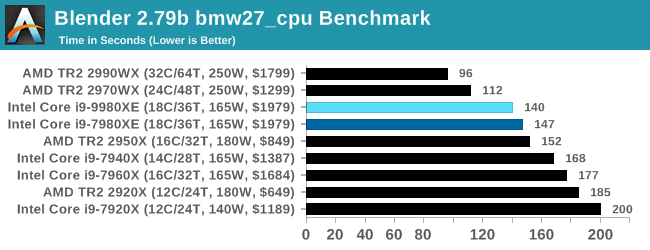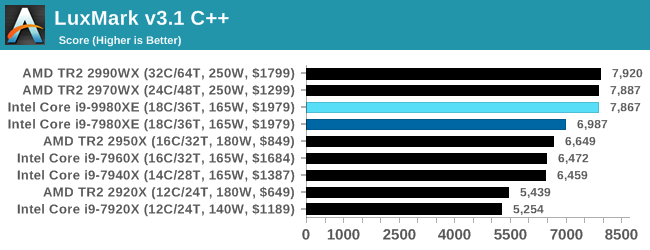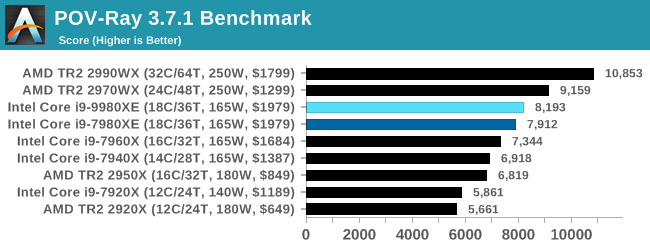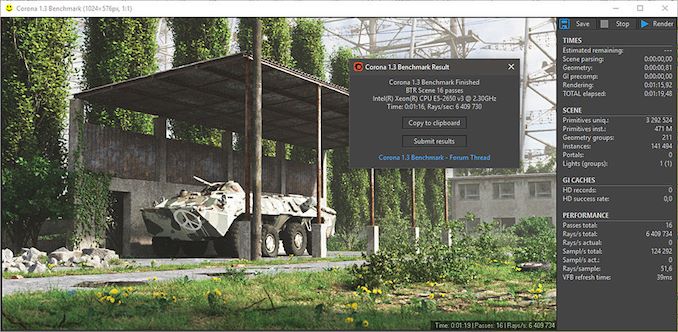The Intel Core i9-9980XE CPU Review: Refresh Until it Hertz
by Ian Cutress on November 13, 2018 9:00 AM ESTHEDT Performance: Rendering Tests
Rendering is often a key target for processor workloads, lending itself to a professional environment. It comes in different formats as well, from 3D rendering through rasterization, such as games, or by ray tracing, and invokes the ability of the software to manage meshes, textures, collisions, aliasing, physics (in animations), and discarding unnecessary work. Most renderers offer CPU code paths, while a few use GPUs and select environments use FPGAs or dedicated ASICs. For big studios however, CPUs are still the hardware of choice.
All of our benchmark results can also be found in our benchmark engine, Bench.
Corona 1.3: Performance Render
An advanced performance based renderer for software such as 3ds Max and Cinema 4D, the Corona benchmark renders a generated scene as a standard under its 1.3 software version. Normally the GUI implementation of the benchmark shows the scene being built, and allows the user to upload the result as a ‘time to complete’.
We got in contact with the developer who gave us a command line version of the benchmark that does a direct output of results. Rather than reporting time, we report the average number of rays per second across six runs, as the performance scaling of a result per unit time is typically visually easier to understand.
The Corona benchmark website can be found at https://corona-renderer.com/benchmark

Corona sees improvement in line with the frequency gain, however the higher core count AMD parts win out here.
Blender 2.79b: 3D Creation Suite
A high profile rendering tool, Blender is open-source allowing for massive amounts of configurability, and is used by a number of high-profile animation studios worldwide. The organization recently released a Blender benchmark package, a couple of weeks after we had narrowed our Blender test for our new suite, however their test can take over an hour. For our results, we run one of the sub-tests in that suite through the command line - a standard ‘bmw27’ scene in CPU only mode, and measure the time to complete the render.
Blender can be downloaded at https://www.blender.org/download/

Similarly with Blender as to Corona: the new Intel Core i9-9980XE performs better than the previous generation 7980XE, but sits behind the higher core count AMD parts.
LuxMark v3.1: LuxRender via Different Code Paths
As stated at the top, there are many different ways to process rendering data: CPU, GPU, Accelerator, and others. On top of that, there are many frameworks and APIs in which to program, depending on how the software will be used. LuxMark, a benchmark developed using the LuxRender engine, offers several different scenes and APIs. *It has been mentioned that LuxMark, since the Spectre/Meltdown patches, is not a great representation of the LuxRender engine. We still use the test as a good example of different code path projections.
In our test, we run the simple ‘Ball’ scene on both the C++ and OpenCL code paths, but in CPU mode. This scene starts with a rough render and slowly improves the quality over two minutes, giving a final result in what is essentially an average ‘kilorays per second’.

Our test here seems to put processors into buckets of performance. In this case, the Core i9-9980XE goes up a bucket.
POV-Ray 3.7.1: Ray Tracing
The Persistence of Vision ray tracing engine is another well-known benchmarking tool, which was in a state of relative hibernation until AMD released its Zen processors, to which suddenly both Intel and AMD were submitting code to the main branch of the open source project. For our test, we use the built-in benchmark for all-cores, called from the command line.
POV-Ray can be downloaded from http://www.povray.org/

POV-Ray is as expected: a performance improvement, but behind the higher core count AMD parts.












143 Comments
View All Comments
nexuspie - Tuesday, November 13, 2018 - link
You're so ghetto you're using a 2500k from 2011? Stop posting and get a job so you can afford an upgrade. I guess it proves that Intel makes good chips though if you can wait this long to upgrade.LordanSS - Tuesday, November 13, 2018 - link
Still rocking a 3770k. Not going to pay "Intel price" for 4-cores and just 20% more IPC than I have.Zen2, that'll be my swap.
Spunjji - Tuesday, November 13, 2018 - link
I seriously don't understand people who are so insecure about their choices that they need to mock random people on the internet for not overspending on their computer equipment. If your use case enables you to spend on the absolute best way past the point of diminishing returns, that's great for you! Be happy and maybe lay off the comment sections..?Kilnk - Tuesday, November 13, 2018 - link
No... all it really means is that for the first time in the history of computing, software demands have allowed computing power to reach the level of "good enough" for a lot of users. Also things are a lot more GPU dependant than they used to be. CPUs are less relevant.duploxxx - Tuesday, November 13, 2018 - link
It is quite obvious. From a general performance/price/power perspective the TR2 2950x is the one to get. Forget all the uber expensive Intel junk.qap - Tuesday, November 13, 2018 - link
I guess it depends on i9-9820X. And I have a feeling it would be similar story to 2990WX vs i9-9980XE - AMD scoring in some benchmarks while intel keeping victory in other.Those who matter (actual buyers) will look at bench that matters to them while fans would be squealing that this or that benchmark is more important and therefore their favorite CPU is the best.
eva02langley - Tuesday, November 13, 2018 - link
I would honestly get an EPYC platform over the TR 32 cores. However, at this point, you have a really particular workload that requires such capabilities.It all depends on your needs, but true, Intel is not competitive at their price tags.
nexuspie - Tuesday, November 13, 2018 - link
These benchmarks show that the 9980's 18 cores often BEAT the 2990wx's 32 cores. AMD cores are garbage.Targon - Tuesday, November 13, 2018 - link
In what world are AMD cores garbage when they are more than competitive enough to push Intel into releasing the first significant changes in six years? Zen2 cores are also here(with the new Epyc chips), and Ryzen 3rd generation will be launching within the next five months or so, which WILL have a higher IPC than Intel at that point.twtech - Thursday, November 15, 2018 - link
The upgrade AMD really needs at this point is a software one - from Microsoft. The 2990WX performs pretty well when using Linux, but it struggles with most workloads in Windows. I hope that Zen 2's chiplets will do a little better in terms of memory access.